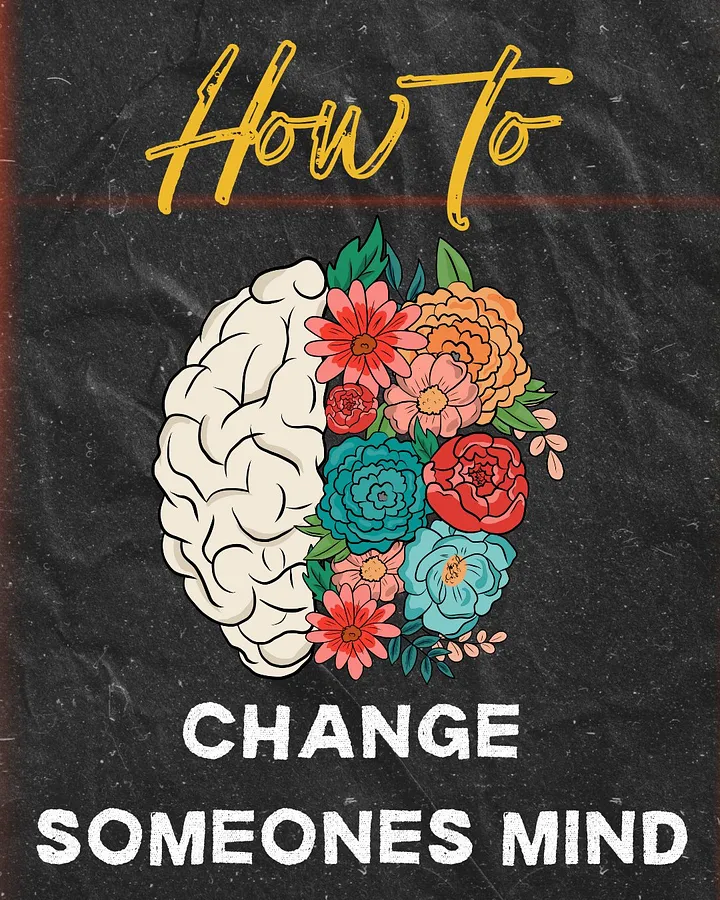
How to get someone to change their mind
Reshaping someone’s mind is like mental surgery. Here are the tricks you can use to help guide a person to new thinking.
You must understand.
You cannot change someones mind.
The have a defense mechanism against this… it’s called the ego.
So if their ego won’t let you through?
What is the other way around?
You have to get them to trip over the truth.
What does that mean?
When you ask specific and relevant questions.
There’s a chance you can expose someone to the flaws in their perceptions.
When you do that correctly, and the light of awareness has exposed the flaw.
The ego needs to correct it, and that’s your opportunity.
This is when you can be the helping hand that adds more perspectives for them to consider.
As they rebuild their new way of thinking.
When they have more information.
That’s when you can hope to help them evolve their beliefs.
So how is it done?
There are four steps:
1️⃣ | UNDERSTAND THEIR INGREDIENTS
2️⃣ | SHORT CIRCUIT THEIR THINKING
3️⃣ | TRIP OVER THE TRUTH
4️⃣ | REBUILD THEIR MENTAL MODEL
This one is going to be a whole framework.
Probably worth a bookmark so you can refer back to later.
But, let’s start with the ingredients…
1️⃣ UNDERSTAND THEIR INGREDIENTS
Whatever opinion a person holds about any topic.
It’s going to be a mixture of perspectives they’ve acquired over time.
And the first step in this process is to understand what ingredients they’re working with.
This is usually easy to spot.
Because most people adopt the ideas of whatever group they believe they belong to.
It could be a:
➥ Religious group
➥ Political group
➥ Culture group
➥ Age group
Once you spot group think.
A few questions will help you verify if they have any free thought or completely adopt the thinking of their in-group.
If they are more of a free thinker…
You’ll have to be more thorough in trying to understand what their foundational beliefs are.
These foundational ideas are usually the support structures for all other ideas on the topic.
So once you’ve understood the other persons ingredients.
The next step is to short circuit their thinking.
2️⃣ SHORT CIRCUIT THEIR THINKING
Most people adopt thoughts from various sources.
Without actually putting in the work to think something through themselves.
They may see a piece of content, take it for face value, and then adopt that idea as their own.
When you do this enough times…
You’ll have a glass house with no foundation.
It’s just a bunch of ideas strung together with no rhyme or reason.
Which makes it really easy to have someone contradict themselves.
The goal here is to look for contradiction.
You want to find two or more conflicting ideas about the way that someone thinks about something.
Because when ideas are in conflict, it short circuits your thinking.
You have to fix it… you can’t just let this broken pattern continue.
What then happens…
Is they have the opportunity to take the authority and solve the mismatch in their logic.
And this is the important part.
You have to give them the authority to make the change.
It’s like the movie Inception…
The other person will only accept the new way of thinking, if they believe they authored it.
If you try to force them to believe something else.
It won’t stick.
3️⃣ TRIP OVER THE TRUTH
Once there is contradiction, and a person has understood their rationale doesn’t work.
You’ve interupted their default programming.
Now, they actually have to do the leg work and think.
They can’t use borrowed thinking anymore.
They have to reason their way out of the problem.
When they try to reason their way out of the problem, they’ll usually go for low hanging fruit.
The lazy way to self correct.
This is your trip over the truth moment.
Because as they are scrambling for some footing to rest their beliefs on.
You’re there to help them disqualify further problematic ideas.
Again…
it’s important that THEY are disqualifying the ideas, NOT YOU.
If you disqualify their ideas.
It may make them feel unsupported or not understood.
When they disqualify, they trip over the truth.
They walk themselves to awareness.
This eventually becomes the…
“Aha” moment.
I’ll give you a quick example.
Let’s look at two scenarios about advising someone on a car purchase
OPTION 1:
You ask them:
➥ “Why do you want this car?”
➥ “Is all that HP really needed?”
➥ “You know the color red has higher car insurance…”
➥ “Don’t you think it’ll be too big?”
Behind all these questions, you’re communicating your disapproval with their choice.
It shows them that they don’t have your support.
OPTION 2:
First ask them the following…
➥ “Why that car?”
➥ “What features does it have?”
➥ “What do you think is the best car you could buy if money didn’t matter?”
Now that they have the mental model you want to create the gap, the contradiction.
The gap between their self described perception of what they like best, and what they are choosing.
➥ “Does X car go as fast as that car you wanted?”
➥ “Does X car look the way you wanted”
➥ “Does this car your buying have that X feature that you wanted?”
Now this doesn’t mean you’ll win them over.
And the point shouldn’t be to win them over.
You just want to encourage them to think more broadly.
To break out of their current level mental model that could have been manipulated.
Do you see how these two scenarios work completely different?
You’ll notice that what the second step does effectively is it helps them build a new mental model.
This brings me to the last step…
4️⃣ REBUILD THEIR MENTAL MODEL
Once you’ve understood the ingredients that someone is thinking with….
You’ve exposed them to the contradictions in their beliefs….
And you’ve allowed them to self disqualify poor perspectives….
The last step is to help them rebuild their mental model.
Because again…
Most people are using borrowed mental models.
Largely built from marketing/advertising, their parents, groups, etc.
So next…
Comes another round of questions with the goal of helping the other person detach.
You want them to rebuild their new thinking without bias, emotional attachments, and other irrational ways of thinking.
So you speak in more generalities…
In ideal circumstances.
Situations outside of themselves.
Because most people don’t even have the strength to think in their best interest.
With these questions…
You’re subconsciously guiding someone to their best interest.
And then after that…
The questions should focus on exposing the gap.
It’s to help them find the contradiction between what they’ve stated is ideal…
And what they are choosing, believing or doing.
This is where it all comes together.
Because now they know there is a mismatch.
They are not in alignment with their true beliefs in whichever way you have shown them.
From this point forward, it’s only up to them where they go.
They have the ultimate choice.
To align with their true believes or not.
You won’t be able to control their decision.
Nor should you want to.
You’ve played your part as the surgeon performing mental surgery.
Which was to identify the mind virus, expose it, and then provide better alternatives
This process should always be approached with good intent.
Because when you have your own bias and motivations.
It will change how you ask questions.
They’ll be able to see your desire to program their beliefs.
Which prevents you from moving any further.
When it comes to changing someones mind about something.
It shouldn’t be about making someone think the way you do.
It should be about freeing them from the constraints of their current thinking.
So then can expand into bigger ideas.
With the hopes, that their broader level of awareness…
Will also changing your thinking too.




